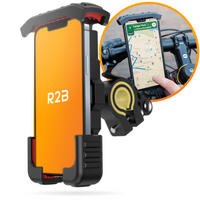No Products in the Cart

How does a bicycle pump with pressure gauge work?
Time to read 2 min
Time to read 2 min
A bicycle pump with a pressure gauge is a handy tool to always bring your tires to the right pressure. The built-in gauge shows exactly how much pressure there is in the tire, so you can prevent adding too much or too little air. In this manual you can read how such a pump works, how to use it and what you should pay attention to.
A bicycle pump with pressure gauge is a pump that has a pressure gauge in addition to a normal pump function. This pressure gauge shows the air pressure in the tire, expressed in bar or PSI (pounds per square inch). This way you know exactly how much air you have added and whether the tire pressure is optimal.
The right tire pressure ensures a smooth ride and prevents unnecessary wear. Under-inflated tires increase rolling resistance, which makes cycling harder. Over-inflated tires reduce road contact, which affects grip and comfort. With a pressure gauge, you can easily check the ideal pressure for your bike.
A bicycle pump with pressure gauge works on the principle of air pressure and vacuum:
Air displacement: When you pull up on the pump, you create a vacuum in the cylinder.
Air inlet: The pump draws in air through the pump housing.
Air supply: When you push the lever down, air is forced into the tire through the hose and valve.
Pressure measurement: The pressure gauge measures the pressure built up in the tire and displays it on the gauge.
Not all bicycles have the same valves. The most common are:
Presta (French valve) : Narrow and often used on racing bikes.
Schrader (Car Valve) : Wider and similar to car tires.
Dunlop (Dutch valve) : Common on city bikes.
Connecting the pump:
Check which valve you have.
Place the pump head on the valve.
Move the pump head lever up or down (depending on the pump type) to create an airtight connection.
Start pumping and keep an eye on the pressure gauge.
The pressure gauge often has two units:
Bar (common in Europe, 1 bar = 14.5 PSI)
PSI (commonly used on mountain bikes and road bikes)
Check the recommended tire pressure on the sidewall of your bicycle tire and pump until you reach this value.
Incorrectly securing the pump head → Air escapes, which takes longer.
Over-inflating → Risk of blowouts and less grip.
Not checking pressure → Under-inflated tires lead to faster wear.
Use your feet to keep the bicycle pump stable.
Pump in a smooth motion without going too fast or too slow.
After pumping, check the pressure and release some air if necessary.

